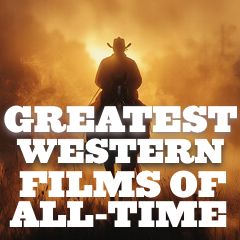
|
100 Greatest Western Films of All-Time |
|
Western Films are the major defining genre of the American film industry, a nostalgic eulogy to the early days of the expansive, untamed American frontier (the borderline between civilization and the wilderness). They are one of the oldest, most enduring and flexible genres and one of the most characteristically American genres in their mythic origins. [The popularity of westerns has waxed and waned over the years. Their most prolific era was in the 1930s to the 1960s, and most recently in the 90s, there was a resurgence of the genre. They appear to be making an invigorating comeback (both on the TV screen and in theatres). Modern movie remakes, such as 3:10 To Yuma (2007) and the Coen Brothers' True Grit (2010) have also paid homage to their mid-20th century predecessors.] This indigenous American art form focuses on the frontier West that existed in North America. Westerns are often set on the American frontier during the last part of the 19th century (1865-1900) following the Civil War, in a geographically western (trans-Mississippi) setting with romantic, sweeping frontier landscapes or rugged rural terrain. However, Westerns may extend back to the time of America's colonial period or forward to the mid-20th century, or as far geographically as Mexico. A number of westerns used the Civil War, the Battle of the Alamo (1836) or the Mexican Revolution (1910) as a backdrop. The western film genre often portrayed the conquest of the wilderness and the subordination of nature, in the name of civilization, or the confiscation of the territorial rights of the original inhabitants of the frontier. Specific settings included lonely isolated forts, ranch houses, the isolated homestead, the saloon, the jail, the livery stable, the small-town main street, or small frontier towns that were forming at the edges of civilization. They may even include Native American sites or villages. Other iconic elements in westerns included the hanging tree, stetsons and spurs, saddles, lassos and Colt .45's, bandannas and buckskins, canteens, stagecoaches, gamblers, long-horned cattle and cattle drives, prostitutes (or madams) with a heart of gold, and more. Very often, the cowboy had a favored horse (or 'faithful steed'), for example, Roy Rogers' Trigger, Gene Autry's Champion, William Boyd's (Hopalong Cassidy) Topper, the Lone Ranger's Silver and Tonto's Scout. Western films have also been called the horse opera, the oater (quickly-made, short western films which became as commonplace as oats for horses), or the cowboy picture. The western film genre has portrayed much about America's past, glorifying the past-fading values and aspirations of the mythical by-gone age of the West. Over time, westerns have been re-defined, re-invented and expanded, dismissed, re-discovered, and spoofed. In the late 60s and early 70s (and in subsequent years), 'revisionistic' Westerns that questioned the themes and elements of traditional/classic westerns appeared (such as Sam Peckinpah's The Wild Bunch (1969), Arthur Penn's Little Big Man (1970), Robert Altman's McCabe & Mrs. Miller (1971), and later Clint Eastwood's Unforgiven (1992)). Westerns Film Plots: Usually, the central plot of the western film was the classic, simple goal of maintaining law and order on the frontier in a fast-paced action story. It was normally rooted in archetypal conflict - good vs. bad, virtue vs. evil, white hat vs. black hat, man vs. man, new arrivals vs. Native Americans (inhumanely portrayed as savage Indians), settlers vs. Indians, humanity vs. nature, civilization vs. wilderness or lawlessness, schoolteachers vs. saloon dance-hall girls, villains vs. heroes, lawman or sheriff vs. gunslinger, social law and order vs. anarchy, the rugged individualist vs. the community, the cultivated East vs. West, the homesteader or settler vs. the drifter-nomad, and farmer vs. industrialist to name a few. Often the hero of a western met his opposite "double," a mirror of his own evil side that he had to destroy. Typical elements in westerns included hostile elements (often Native Americans), guns and gun fights (sometimes on horseback), violence and human massacres, horses, trains (and train robberies), bank robberies and holdups, runaway stagecoachs, shoot-outs and showdowns, outlaws and sheriffs, cattle drives and cattle rustling, stampedes, posses in pursuit, barroom brawls, 'search and destroy' plots, breathtaking settings and open landscapes (the Tetons and Monument Valley, to name only a few), and distinctive western clothing (denim, jeans, boots, etc.). Western heroes were often local lawmen or enforcement officers, ranchers, army officers, cowboys, territorial marshals, or a skilled, fast-draw gunfighter. They were normally masculine persons of integrity and principle - courageous, moral, tough, solid and self-sufficient, maverick characters (often with trusty sidekicks), possessing an independent and honorable attitude (but often characterized as slow-talking). The Western hero could usually stand alone and face danger on his own, against the forces of lawlessness (outlaws or other antagonists), with an expert display of his physical skills (roping, gun-play, horse-handling, pioneering abilities, etc.). Subgenres of Westerns: There are many subgenres of the typical or traditional western, to name a few:
Influences on the Western: In many ways, the cowboy of the Old West was the American version of the Japanese samurai warrior, or the Arthurian knight of medieval times. [Note: No wonder that westerns were inspired by samurai and Arthurian legends, i.e., Kurosawa's Yojimbo (1961) served as the prototype for Clint Eastwood's A Fistful of Dollars (1964), and Kurosawa's The Seven Samurai (1954) was remade as John Sturges' The Magnificent Seven (1960). Le Mort D'Arthur by Sir Thomas Malory also inspired much of Shane (1953) - a film with a mythical western hero acting like a noble knight in shining leather in its tale of good vs. evil.] They were all bound by legal codes of behavior, ethics, justice, courage, honor and chivalry. More About Western Films:
|
 Introduction to the Western Films Genre |
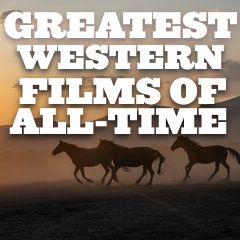
|
The linked titles below refer to reviews (with screenshots) in the "Greatest Moments and Scenes" section of the site |
||||
 The Great Train Robbery (1903) |
 The Covered Wagon (1923) |
 The Iron Horse (1924) |
 Tumbleweeds (1925) |
 The Big Trail (1930) |
 Cimarron (1931) |
 The Plainsman (1936) |
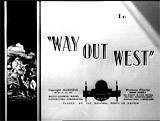 Way Out West (1937) |
 Destry Rides Again (1939) |
 Dodge City (1939) |
 Jesse James (1939) |
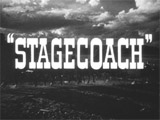 Stagecoach (1939) |
 Union Pacific (1939) |
 The Westerner (1940) |
 The Outlaw (1943) |
 The Ox-Bow Incident (1943) |
 Duel in the Sun (1946) |
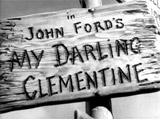 My Darling Clementine (1946) |
 Pursued (1947) |
 Fort Apache (1948) |
 Red River (1948) |
 3 Godfathers (1948) |
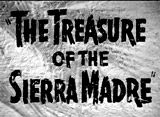 The Treasure of the Sierra Madre (1948) |
 Yellow Sky (1948) |
 She Wore a Yellow Ribbon (1949) |
 Broken Arrow (1950) |
 The Gunfighter (1950) |
 Rio Grande (1950) |
 Winchester '73 (1950) |
 Bend of the River (1952) |

High Noon (1952) |

Rancho Notorious (1952) |
 Hondo (1953) |
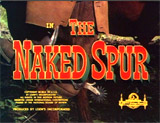 The Naked Spur (1953) |
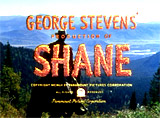 Shane (1953) |
 The Far Country (1954) |
 Johnny Guitar (1954) |
 River of No Return (1954) |
 Silver Lode (1954) |
 Vera Cruz (1954) |
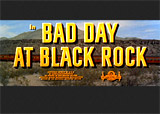 Bad Day at Black Rock (1955) |
 The Man From Laramie (1955) |
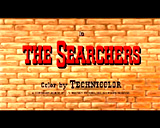 The Searchers (1956) |
 Seven Men From Now (1956) |
 Decision at Sundown (1957) |
 Forty Guns (1957) |
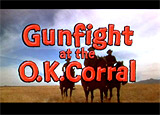 Gunfight at the O.K. Corral (1957) |
 The Tall T (1957) |
 3:10 To Yuma (1957) |
 The Tin Star (1957) |
 The Big Country (1958) |
 Cowboy (1958) |
 Man of the West (1958) |
 The Horse Soldiers (1959) |
 Ride Lonesome (1959) |
 Rio Bravo (1959) |
 Comanche Station (1960) |
 The Magnificent Seven (1960) |
 The Unforgiven (1960) |
 The Comancheros (1961) |
 One-Eyed Jacks (1961) |
 Two Rode Together (1961) |
 How the West Was Won (1962) |
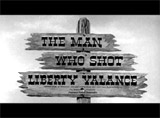 The Man Who Shot Liberty Valance (1962) |
 Ride the HIgh Country (1962) |
 Fistful of Dollars (1964, It.) |
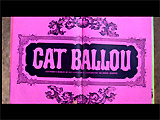 Cat Ballou (1965) |
 For a Few Dollars More (1965, (It.) |
 El Dorado (1966) |
 The Good, The Bad and the Ugly (1966, It.) |
 The Professionals (1966) |
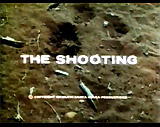 The Shooting (1966) |
 Hombre (1967) |
 Hang 'Em High (1968) |
 Once Upon a Time in the West (1968, It.) |
 Butch Cassidy and the Sundance Kid (1969) |
 True Grit (1969) |
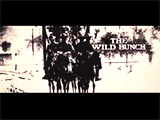 The Wild Bunch (1969)< |
 Chisum (1970) |
 El Topo (1970, Mex.) |
 Little Big Man (1970) |
 A Man Called Horse (1970) |
 McCabe & Mrs. Miller (1971) |
 Jeremiah Johnson (1972) |
 Ulzana's Raid (1972) |
 High Plains Drifter (1973) |
 Pat Garrett & Billy the Kid (1973) |
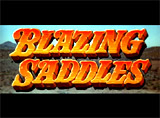 Blazing Saddles (1974) |
 The Outlaw Josey Wales (1976) |
 The Shootist (1976) |
 Heaven's Gate (1980) |
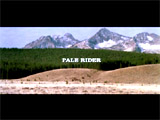 Pale Rider (1985) |
 Silverado (1985) |
 Dances With Wolves (1990) |
 Unforgiven (1992) |
 Tombstone (1993) |
 Maverick (1994) |
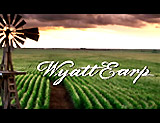 Wyatt Earp (1994) |
 Open Range (2003) |
 The Proposition (2005, Australia-UK) |
 The Assassination of Jesse James by the Coward Robert Ford (2007) |
 No Country For Old Men (2007) |
 3:10 To Yuma (2007) |
 Appaloosa (2008) |
 True Grit (2010) |
 Django Unchained (2012) |
 The Hateful Eight (2015) |
 The Revenant (2015) |
 Hell or High Water (2016) |
|